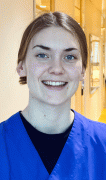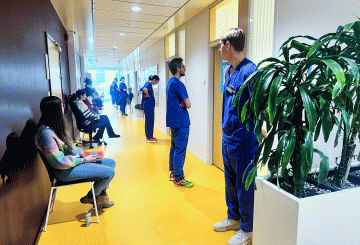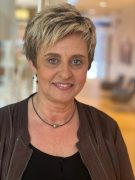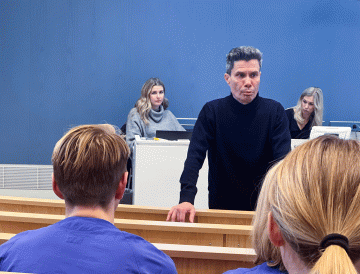EDUCATION. After several minutes of silence, a whistle echoes through the corridor. At the signal, the doors swing open, and medical students prepare for the next task. Everything went smoothly as the new medical program conducted its first examination using the OSCE model, involving around fifty teachers and administrators.
OSCE (Objective Structured Clinical Examination) is a practical assessment that simulates clinical situations. Practical clinical skills and the ability to interact and communicate with a patient or colleague are evaluated according to a structured template, for instance, when a student performs a lumbar puncture, observes correct hygiene procedures, or administers a vaccination correctly.
Nervous atmosphere
Students in the fifth semester were the first to be examined with OSCE in the new medical program. To examine all students, there were two parallel circuits with six active stations each and three rest stations.

Alma Toftgård, one of the over 120 students, found the examination very strict, but she was prepared for it. Students had exactly two minutes to read the instructions on the door and then six minutes to complete the task presented in each room.
“It was a scary but also fun form of examination! I had practiced the different tasks before, and it felt like I had a reasonable handle on it. But the atmosphere leading up to OSCE built up some nervousness,” she says.
![]() What was the most challenging – and what was the most enjoyable?
What was the most challenging – and what was the most enjoyable?
“The most challenging part was probably being questioned by the person playing a patient reluctantly receiving a vaccination. And the most enjoyable part was showing that you know something!”
After the examination, many students requested more opportunities to practice, particularly for the lumbar puncture, where several felt that time was insufficient.
Assessors and corridor guards

OSCE assesses the knowledge students have acquired related to EPA (Entrustable Professional Activities). EPA is the structure that guarantees progression and documentation for medical students’ clinical training in the new program. Educational coordinator Maria Mardini has administrative responsibility for both these cornerstones in clinical training.
“Minute planning was required for OSCE. The work for the two days has been ongoing for the past two years, and more intensively in the last six months,” says Maria, continuing, “We have to ensure that we get the right student in the right room at the right time. To make it as easy as possible for assessors, this time we provided all assessors with binders containing assessment templates on paper for each student. It involves more administrative work, but we wanted to simplify it for the assessors.”
Administrators step in
The Institute of Biomedicine also make significant contributions during the examination. Over two days, eight individuals per day from the administrative team and also eight doctoral students served as corridor guards and timekeepers with whistles. The institute’s administrative manager, Birgitta Vallhagen, brought her personal judge’s whistle for the task during the examination:

“Many of our administrators were probably a bit nervous about the task since it’s something entirely new for them. But once the examination was underway, I think everyone found it to be a fun and different job,” says Birgitta.
Recurring OSCE
In the new medical program, OSCE takes place for the first time in the fifth semester. OSCE will be conducted again in May for the next batch of medical students in the fifth semester. On the ninth semester, a more extensive OSCE will also occur, based on a broader knowledge base and higher demands. The surgery course in the seventh semester will also have an examination following the OSCE model.

“The most important aspect of the OSCE exam is that the practical elements of medical education gain more significance and weight in training than before,” says Johan Westin, professor of infectious diseases and coordinator for the fifth semester.
All the elements examined under OSCE are linked to EPA, practical medical procedures that students have practiced and documented in their educational portfolios. Students in the fifth semester are not expected to know everything perfectly. They do not need to demonstrate the same independence as when they graduate and receive their medical licenses.
Easier next time
“Executing OSCE is truly a massive undertaking! It has been a significant effort to put together OSCE now that we are doing it for the first time in the new medical program, but hopefully, it will be a bit easier next time,” says Malin Veje, adjunct senior lecturer in the Department of Infectious Diseases with special responsibility for OSCE.
Lena Björkman, adjunct senior lecturer in the Department of Rheumatology and Inflammation Research, will take over as the course leader for the course concluding with OSCE in the fifth semester:
“Now we know how to organize our OSCE. We have already started thinking about how to make the examination a bit more enjoyable next time. We will also introduce new clinical cases in the different rooms,” says Lena.
Previous OSCE Experience

Lars Börjesson is chairman of the medical program committee at the Sahlgrenska Academy:
“We have prior experience from conducting OSCE for the National Board of Health and Welfare’s knowledge test for doctors with degrees from countries outside the EU and EEA, which was a significant advantage as we now begin implementing OSCE for our own undergraduate students,” says Lars Börjesson.
Similar to the National Board of Health and Welfare’s knowledge test, OSCE in the new medical program takes place in the R-building at Mölndal Hospital, where the Simulation Center West has facilities.
“We see an increasing need for facilities both for OSCE and for skills training. Our current Clinical Training Center is not large enough to accommodate an entire course of medical students for this examination form,” concludes Lars Börjesson.
BY: ELIN LINDSTRÖM











